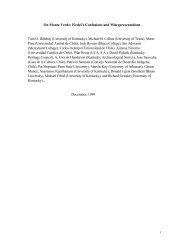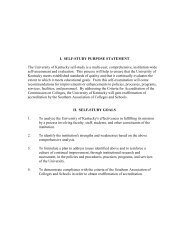Flexible Workplace Solutions for Low-Wage Hourly Workers
Flexible Workplace Solutions for Low-Wage Hourly Workers
Flexible Workplace Solutions for Low-Wage Hourly Workers
Create successful ePaper yourself
Turn your PDF publications into a flip-book with our unique Google optimized e-Paper software.
The second important distinguishing feature of low-wage hourly workers’ schedules is whether<br />
those schedules are full-time or part-time. Working full-time is more common among workers in lowwage<br />
hourly jobs on both standard and nonstandard schedules than working part-time. However, a<br />
signifi cantly higher percentage of low-wage hourly workers on nonstandard schedules work part-time<br />
compared to those on standard schedules, 43% vs. 14%.<br />
Many of these part-time workers would prefer<br />
to work more hours. We categorize the problem<br />
of involuntary part-time work as schedule<br />
instability, which we discuss in depth in Part 2.<br />
About 45% of low-wage hourly workers working<br />
nonstandard schedules (part-time and full-time)<br />
indicated that a daytime shift was the most<br />
common shift they were scheduled to work,<br />
followed by an evening shift, rotating shift,<br />
variable or split shift, and night shift. (See<br />
Table 4).<br />
Growth Trends in <strong>Low</strong>-<strong>Wage</strong><br />
Jobs<br />
The U.S. DOL’s occupational projections<br />
<strong>for</strong> 2008 to 2018 show that seven out of<br />
the ten occupations in which job growth<br />
was predicted are typically low-wage<br />
occupations. 53 The industry sectors in which<br />
economic growth is occurring — retail,<br />
service, and health care — are industries<br />
with a high proportion of low-wage jobs. 54<br />
TABLE 3: Schedule Types of <strong>Workers</strong><br />
in <strong>Low</strong>-<strong>Wage</strong>, <strong>Hourly</strong> Jobs<br />
Full-time<br />
Part-time<br />
Regular daytime<br />
Regular evening<br />
Regular night shift<br />
Rotating shift<br />
Split, flexible, variable,<br />
or other type of shift<br />
Standard<br />
hours<br />
86.5%<br />
13.5%<br />
48.4%<br />
12.9%<br />
11.8%<br />
13.9%<br />
12.9%<br />
Nonstandard<br />
hours<br />
56.5%<br />
43.5%<br />
TABLE 4: Schedule Types of Employees<br />
Who Work Nonstandard Hours<br />
Full-time<br />
Part-time<br />
44.8%<br />
18.9%<br />
5.6%<br />
15.4%<br />
15.3%<br />
In particular, the U.S. DOL projects that<br />
the retail sector will add 1 .6 million new<br />
jobs, reaching 16.7 million by 2014, and<br />
will continue to be the dominant source<br />
of employment and the largest source of<br />
employment growth in America. 55 This tracks<br />
past growth trends: the retail and service<br />
sector accounted <strong>for</strong> more than 83% of all<br />
new jobs between 1989 and 1995. 56<br />
Many jobs in the industries and occupations<br />
with projected growth often have limited<br />
access to fl exible work arrangements, and<br />
have been characterized as having rigid,<br />
unstable, and unpredictable scheduling<br />
practices that strain working families. 57<br />
12

















